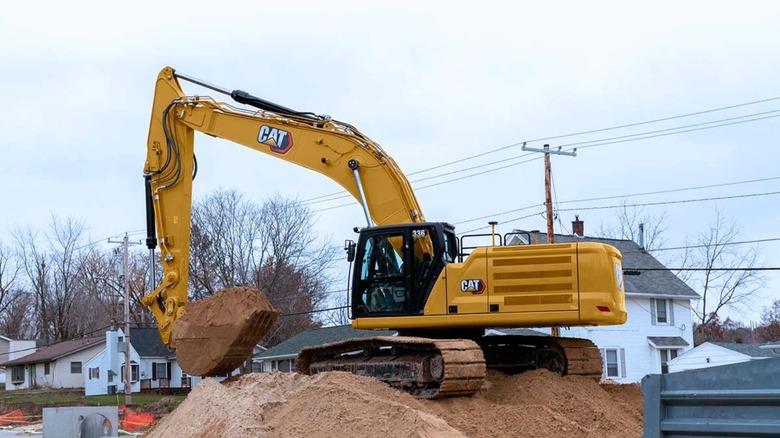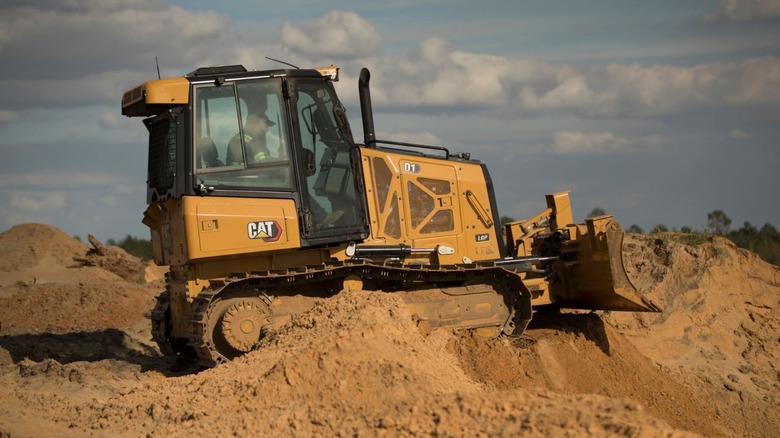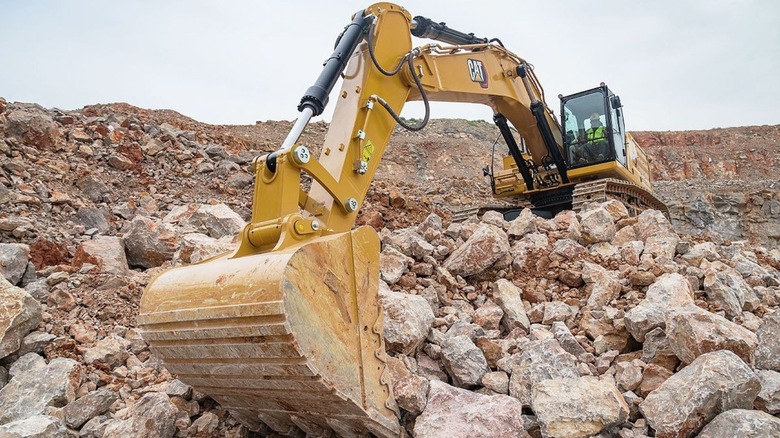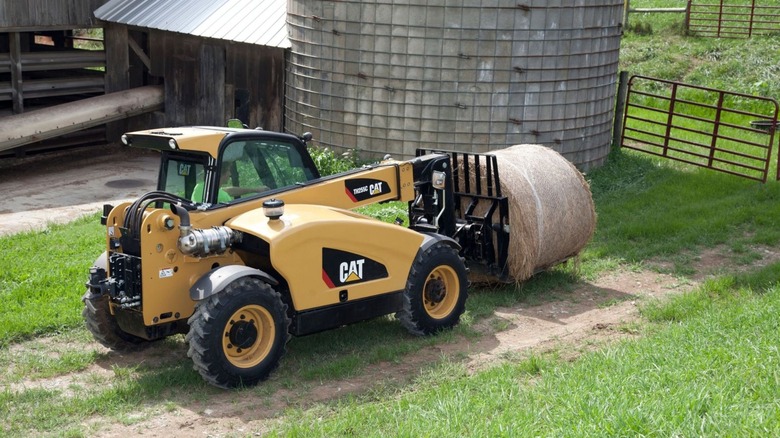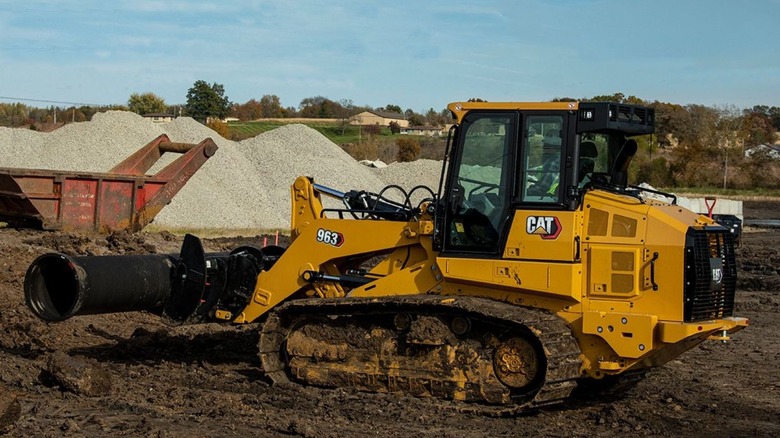What License Do You Need To Operate Heavy Caterpillar Trucks And Machinery?
It seems anywhere you look in a budding city, Caterpillar or CAT has its trucks hard at working hard. From new communities to expanded roadways, the CAT brand has remained integral to the evolution of even the smallest towns. It may inspire some to want to get in on the construction game or even rent one of the yellow behemoths for an extensive commercial or home development project. Renting heavy trucks or machinery is made quite easy via CAT's official website, so why not jump on the opportunity? After all, CAT even notes that its rental equipment is best for short-term jobs and new construction businesses.
Before you even consider jumping behind the wheel of one of these earthmovers, though, you'll want to ensure you're even legally able to drive one. It's maybe been a while since you secured a standard driver's license, so you may not immediately remember the restrictions imposed. For example, a basic license allows you to drive passenger vehicles that weigh less than 26,000 lbs. However, much of CAT's available equipment comes in way over that weight limit, such as the 1.38 million lb 797F large mining truck, which has an engine alone that weighs 51,000 lbs.
The FMCSA's CDL rules don't necessarily require a Commercial Driver's License (CDL) for operating Caterpillar's heavy equipment on a private job site, or for occasionally driving that equipment between sites on public roads. Individual state rules may insist upon it, however, and you'll need a CDL to transport heavy equipment on a tractor-trailer or similar. Those looking to rent Caterpillar equipment, meanwhile, may discover the rental company insists on proof of a CDL being held, in addition to relevant OSHA safety training and insurance, and regardless of whether that equipment is to be used on private sites.
Licensing requirements for driving Caterpillar equipment
Let's get one thing out of the way. You may have come across "heavy equipment certifications" while looking for information on the proper licensing. That's not the same thing as a CDL. Caterpillar does offer its own certification, but we'll touch on that shortly and why you may want to consider participating. As for the licensing, the CDL is the only one you need to look into.
There are three different CDL classes: A, B, and C. Class C is the least in line with what you're looking to do, instead covering things like HAZMAT vehicles and vans with at least 16 passengers. Class A and Class B sound similar at first, but the devil is in the details. A Class A CDL allows you to operate a combination of vehicles with a gross weight of 26,001 lbs or more. According to the Department of Motor Vehicles, you'll also want a CDL A if towing a vehicle that is heavier than 10,000 lbs.
Class B, on the other hand, has a few limitations. Per the Federal Motor Carrier Safety Administration (FMCSA), Class B licenses are good for only one vehicle weighing 26,001 lbs or more. You can also tow a gross weight of up to 10,000 lbs.
How do you get a CDL classification?
Securing a commercial license is a little more involved and extensive than getting a standard license. These steps are for a Class A or Class B CDL classification only, as those are the two you'd consider for operating CAT heavy machinery. The most basic requirement is that you already have to have a non-commercial driver's license, so stop here if you're not in possession of a standard license yet.
If you do have a basic license, your first step is a commercial learner's permit (CLP). According to the FMCSA, this permit "only authorizes you to practice on public roads with a qualified CDL holder sitting next to you." There's a knowledge test involved, and your driver's history will be checked in all 50 states. FMCSA also notes that you will most likely need a Department of Transportation (DOT) medical card, obtainable after a DOT physical. Physicals are good for only 24 months and must be performed by a medical professional listed on the Federal Motor Carrier Safety Administration National Registry.
With a CLP secured, you'll move on to entry-level driver training. Check state requirements for additional entry-level driver requirements, as they may differ from the Federal standards. This training is performed by a registered trainer, who then issues a certificate of completion, allowing you to pursue the final step: Three skill tests. For CDL issuance, you need to pass the Vehicle Inspection, Basic Controls, and Road Tests.
Complying with OSHA standards
In 2016, OSHA issued a statement in response to a mailed letter inquiring about required certifications for anyone looking to operate heavy equipment. Though OSHA responded by reaffirming that no official certification is required, there is still a matter of training that must be addressed. In its response, OSHA refers to Standard Number 1926.21(2), which addresses training requirements as they pertain to employers and employees. Per the Standard, all employees must be instructed "in the recognition and avoidance of unsafe conditions and the regulations applicable to his work environment to control or eliminate any hazards or other exposure to illness or injury."
While that doesn't specifically pertain to operating heavy equipment, as a heavy equipment operator, employees are in a position to create a hazardous work environment and, therefore, should be trained on protocols to avoid these instances. This is carried over to Standard 1910.178(l) under guidance for powered industrial trucks. Also mentioned in the response to the letter, OSHA requires that all employees be "trained and certified by their employer" before operating industrial trucks.
In the case of this Standard, powered industrial trucks include fork trucks, platform lifts, tractors, motorized hand trucks, and virtually any "specialized industrial trucks powered by electric motors or internal combustion engines." It's worth noting, though, that it does not cover "earth moving or over-the-road hauling," which can include some of Caterpillar's machines.
What are Caterpillar's training courses?
For CAT equipment, knowing whether you need a CDL classification at all depends on the equipment you need to operate. Smaller dozers like the D1 model have an operating weight of 17,855 lbs. In this case, a standard driver's license would work. Though, in this case, heavy equipment certificates aren't legally required, they could be a worthwhile investment if you're new to operating heavy equipment, and some work sites may require previous experience.
A heavy equipment certificate of completion is available through Caterpillar, with three training levels catering to everyone from newcomers to construction professionals. Drivers who have never operated heavy equipment before may consider CAT's Level 1 Competent Operator Training. Available at a Caterpillar facility for $1,500 (or $2,400 – $3,600 for job site training), the two-day course introduces enrolees to an extensive line of CAT heavy equipment and trucks, from backhoe tractors to articulated trucks. The coursework is intended for anyone brand new to heavy equipment operation or entry-level workers with less than three years of experience.
Level 2 Professional Operator Training is designed to improve operator skills. At the same cost as Level 1, this training is catered to anyone with three or more years of experience behind CAT equipment. The third level, which requires completion of Level 2, bumps the price up quite a bit to a minimum of $1,700 per enrollee per day ($3,400 for the two-day training) and is an in-depth, hands-on assessment to determine one's experience and comfort behind CAT's product families, like CAT's track loaders.
